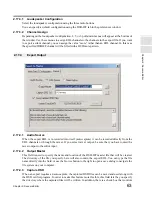
58
Chapter 2: Sonoma Editor
C
hap
te
r 2:
So
no
m
a
Edi
tor
The pull-down menu will only contain a list of the permissible conversion types.
Pressing the change button will delete the selected mark and add a new mark of the specified type,
copying the mark info. from the old to the new mark. (Note that if the type is changed to ingredient
mark and more than one ingredient is selected, multiple ingredient marks may be added.)
Pressing the copy button will add a new mark of the specified type, copying the mark info. from the
old to the new mark. (Copy is useful for duplicating EDL/authoring marks and ingredient marks
without losing either one.)
The audition mark command in the marks menu can be used to simulate the behavior of a target
SACD player. The command is enabled when you have selected a single Start or Index mark in the
mark list. The system will play a selection with a length equal to the currently selected pre-roll,
starting at the Start or Index mark, or ending at the End mark. The calculation of the mark’s position
will include its offset if one was specified. This command uses a ramp time of 50 msec., or an
alternate ramp time if one is specified in the playback preferences dialog.
The mark list can be saved to a printable text file in two different formats. Two save commands
appear at the end of the marks menu.
2.15.7.1
Save Mark List to Text File
This command will produce a text file that contains a copy of the mark list as it appears in the EDL’s
mark panel. The current timecode format will be used and only the currently visible mark types (as
selected with the check boxes in the mark editor control panel) will be included.
2.15.7.2
Save PQ List to Text File
This command produces a text file that is similar to a DAQ-1000 PQ list. Only valid authoring marks
are used to produce this list: ingredient marks, EDL marks, and invalid authoring marks are ignored.
Comments attached to Start marks will appear in the file, other comments on Index and End marks
will not appear. For best results, this command should be used on the export EDL that is created after
you perform the DSD-IFF export command.
The Sonoma editor stores waveform data for each DSD file in a corresponding envelope file with an
env
extension. When an ingredient references a DSD file that has an accompanying
env
file, Sonoma
will draw the waveform inside the ingredient. When a raw DSD file (without a matching
env
file) is
imported directly into Sonoma, or when a DSD file is extracted from a DSD-IFF file, you can use the
Make Waveforms command to create an
env
file.
Sonoma can also show the input monitor audio stream as a waveform. The commands to control
waveforms are found on the waveform menu.
2.15.6
Auditioning an Authoring Mark
2.15.7
Saving the Mark List
2.16 Waveforms






























